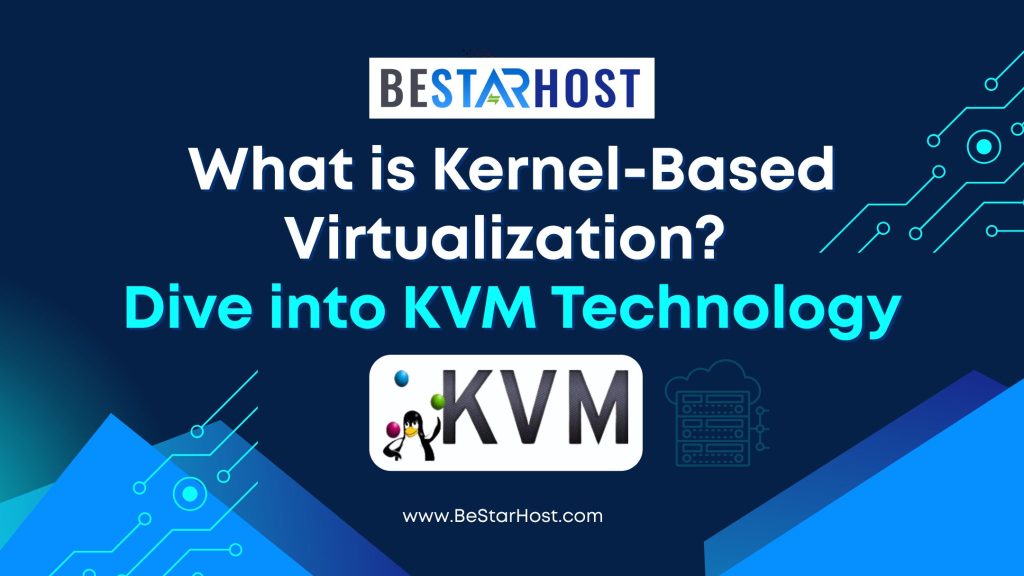 Virtualization has revolutionized the way we manage computing resources. Among the most efficient and open-source options available today is Kernel-Based Virtualization, powered by KVM (Kernel-based Virtual Machine). If you’re looking to optimize server performance and scalability, understanding KVM virtualization is essential.
Virtualization has revolutionized the way we manage computing resources. Among the most efficient and open-source options available today is Kernel-Based Virtualization, powered by KVM (Kernel-based Virtual Machine). If you’re looking to optimize server performance and scalability, understanding KVM virtualization is essential.
In this comprehensive guide, we will explore what kernel-based virtualization technology is, how it works, and how to set it up using our practical Linux KVM tutorial.
What Is Kernel-Based Virtualization?
Kernel-based virtualization is a method where the host operating system, typically Linux, utilizes its own kernel to act as a hypervisor. This allows multiple guest systems to run concurrently on a single physical machine, providing efficient use of hardware resources.
The most widely adopted implementation of this is the Kernel-based Virtual Machine (KVM), built directly into the Linux kernel since version 2.6.20.
What is KVM (Kernel-Based Virtual Machine)?
KVM is an open-source virtualization solution that transforms Linux into a bare-metal hypervisor. Originally developed by Qumranet, KVM has grown to be a core technology in data centers, cloud platforms like OpenStack, and hosting services like BeStarHost.com.
With KVM, each virtual machine is treated as a regular Linux process, managed by the kernel’s scheduler. It supports a wide range of guest operating systems including Linux, Windows, BSD, and others.
How KVM Works
Here’s a breakdown of how KVM works to provide efficient virtualization:
- Kernel Module: KVM includes core modules like
kvm.koand eitherkvm-intel.koorkvm-amd.kodepending on the processor. - User-space Tools: Tools like QEMU emulate hardware for the guest OS.
- Hardware Support: KVM leverages Intel VT-x or AMD-V extensions for hardware-assisted virtualization.
- Isolation: Each VM runs as a secure, isolated Linux process.
Benefits of KVM Virtualization
- Open Source: No licensing fees and backed by a strong developer community.
- High Performance: Near-native performance thanks to hardware-level virtualization.
- Scalability: Easily scale up by adding more virtual machines.
- Security: Uses Linux security modules like SELinux and AppArmor.
- Live Migration: Migrate VMs between physical servers without downtime.
These benefits make KVM virtualization an ideal solution for VPS hosting environments and cloud infrastructure.
Linux KVM Tutorial: Getting Started
Follow this Linux KVM tutorial to set up a KVM-based virtual machine on your server.
Step 1: Check for Virtualization Support
egrep -c '(vmx|svm)' /proc/cpuinfoA non-zero result means your hardware supports virtualization.
Step 2: Install KVM and Dependencies
Ubuntu/Debian:
sudo apt update
sudo apt install qemu-kvm libvirt-daemon-system libvirt-clients bridge-utils virt-managerCentOS/RHEL:
sudo yum install qemu-kvm libvirt libvirt-python libguestfs-tools virt-installStep 3: Start and Enable libvirtd
sudo systemctl enable libvirtd
sudo systemctl start libvirtdStep 4: Verify Installation
virsh list --allStep 5: Create Your First Virtual Machine
sudo virt-install \
--name ubuntuVM \
--ram 2048 \
--disk path=/var/lib/libvirt/images/ubuntuVM.img,size=10 \
--vcpus 2 \
--os-type linux \
--os-variant ubuntu20.04 \
--network network=default \
--graphics vnc \
--cdrom /path/to/ubuntu.isoAdvanced KVM Use Cases
- Nested Virtualization: Useful for testing environments and cloud development.
- Live Migration: Seamlessly move VMs with zero downtime.
- Snapshots: Take consistent VM backups using
virsh snapshot-create. - Cloning: Duplicate environments quickly with
virt-clone.
Kernel-Based Virtualization vs. Other Technologies
| Feature | KVM | VMware ESXi | Microsoft Hyper-V |
|---|---|---|---|
| License | Open-source | Proprietary | Proprietary |
| Performance | Near-native | Excellent | Good |
| Cloud Integration | OpenStack, oVirt | vSphere | Azure Stack |
| Security | SELinux, AppArmor | vShield | Windows Defender |
Why BeStarHost Recommends KVM Virtualization
At BeStarHost.com, we leverage kernel-based virtualization technology for our dedicated server and cloud VPS offerings because it ensures:
- High-performance hosting
- Secure isolation between virtual environments
- Scalability for business growth
- Cost-effective infrastructure
We provide enterprise-grade infrastructure powered by KVM virtualization to help your business run efficiently and securely.
Conclusion
Understanding kernel-based virtualization and how KVM works is crucial for businesses and developers looking to maximize server potential. From strong performance to top-tier security and flexibility, Kernel-based Virtual Machine (KVM) delivers unmatched value.
If you’re ready to harness the power of KVM for your hosting needs, explore the robust plans at BeStarHost.com today.
Recommended Reading:
- Top 6 WHOIS Lookup Alternatives to Find Domain Owners
- 8 Security Benefits of Using Enterprise Hosting for Your Business
- KVM Official Documentation
